- [email protected]
- 1-812-975-3627

- Learn Cursive
- Teach Cursive
- Cursive Worksheets
- Cursive Generator
- Cursive Letters


Cursive Writing Style: Exploring Types of Cursive Writing
August 30, 2023 - Updated on February 21, 2024

Cursive writing is a style of writing where all the letters in a word connect. The interconnection gives a piece of writing a beautiful pattern that is pleasant to the eye. Cursive has been around for hundreds of years and is still taught in schools across the U.S.

We shall be looking at this writing and how one can discover their cursive writing style.
Cursive was a common writing practice for decades and is now only popular used when signing a name.
Types of Cursive Writing
There are different types of cursive writing styles. We list several of the most popular types of cursive writing being taught, along with a brief description, below. You can also find some tips when choosing a cursive style for yourself and children.
Let’s dive into popular cursive writing style.
1. New American Cursive
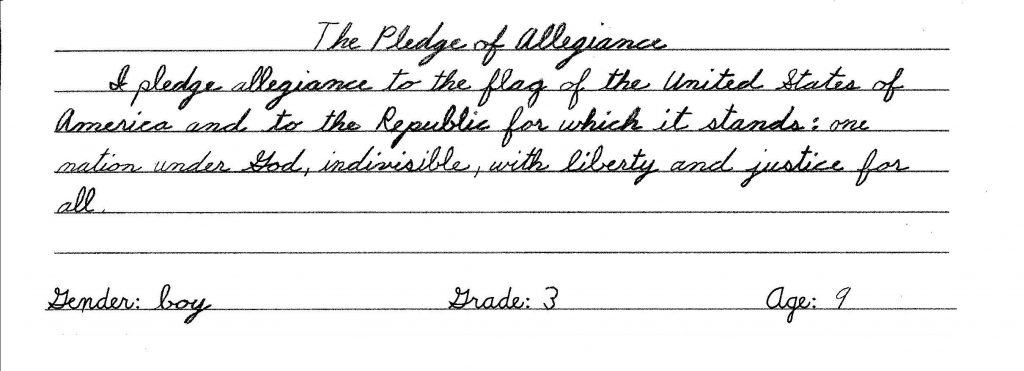
New American cursive is a relatively easy style to teach. Often an entry-level cursive writing course. All the letters are written slanting a bit to the right. The type is simple since complicated strokes are not included in writing. It is not as taxing as other cursive styles when it comes to left-handed people and children.
2. D’Nealian Handwriting
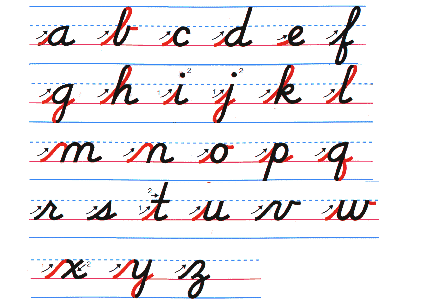
In this cursive writing, the hooks on the tails of every letter connect to the next tail of another letter. To learn this cursive form, one must go through D’Nelian manuscript to master it since it is the basis of the cursive writing. In this type, the writer writes continuously without lifting the pen to obtain non-stop strokes.
3. Zane-Bloser Cursive Writing
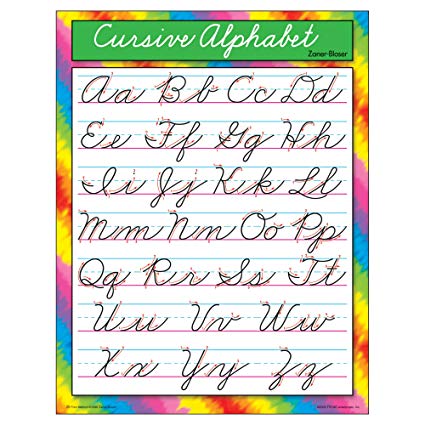
The cursive handwriting contains letters that slant to the right with hooks similar to those of D’Nealian’s letter structure. It also has capital letters that are simplified. This is the style many of us grew up on in grade school and cut our teeth learning to write our name with Zane-Bloser .
4. Hand Writing Without Tears
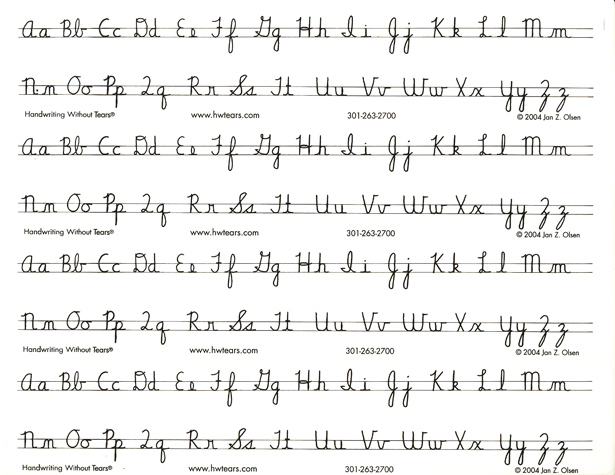
Hand writing without tears is cursive writing designed to make letters clear with the least continuous flow strokes. This style is more for teaching children basic cursive writing and reading. It is almost like typed letters, meaning great clarity and letter recognition.
5. Introducing the MyCursive Style!
We’ve been working hard to make it easier for parents and teachers to teach their students to write in cursive. Now, the MyCursive Cursive Curriculum is live!
In our course and curriculum, your learners will learn to write in a font, called “Learning Curve.” For parents, there is a full step-by-step video course your kids can follow along with. For teachers, we offer the full curriculum, organized in a way that helps you teach it to students.
Both the course and curriculum include:
- 3 teaching plans to choose the best path for your students
- More than 130 worksheets (organized for easy assignments)
- Hours of video tutorials (they’re laid out in order in the course and all available for teachers navigating e-learning)
Click here to find out more, and to get LIFETIME Access to either the course or the teacher’s curriculum.
Oh, and here’s a quick example of one of the video lessons, from the course:
6. Spencerian Cursive (or Spencerian Script)
This is one of the oldest, and arguably most beautiful forms of writing. It’s also a difficult place to start when beginning your cursive journey. That said, it’s really fun to look at and the ability to write in this gorgeous style is something worth striving to achieve.
This type of cursive is essentially calligraphy, on is an introduction to the entire world of calligraphy writing.
Fun fact: Another name for Spencercian is “Copperplate” and you can find out more information on it here.
Choosing a Child Handwriting Font
As with reading, children are introduced to the art of writing right from infancy. By observing you as you write, your toddler starts understanding from a tender age that written words are important. From that point, it’s only a matter of time before they start scribbling and drawing.
A crucial factor that you should take into account when you’re teaching your child handwriting is the type of font you use. You want to use a font that’s not only colorful but also readable.
Here are a couple more tips to help you choose the right font for teaching your toddler how to write.
Check with Their Teacher
There are a growing number of states where public schools are required to teach cursive . If cursive is taught in your child’s public school, then you’ll likely want to use the same font or style!
Further reading: We have an updated list of the states legally required to teach cursive .
Text Legibility
When picking a font to train your child, look for one that has a warm and friendly design. In other words, all the letters and shapes should be designed in a simple way.
The easiest way to know if a font is simplified enough for a toddler is to focus on the counters (the enclosed sections within letters). These should be circular and open as opposed to being rectangular or angular.
Also, stay away from fonts that use unconventional letterforms. Sassoon Primary is a good example of a font that meets all these requirements, and it’s specially designed for children.
Another thing to consider is whether the font uses large or short x-height. Put simply; this is the height of lowercase letters that’s based on the height of lowercase x. For a kid’s font, you’ll want to go for one with larger x-heights as it will be easier to read.
Other fonts that are often recommended for preschool and school-age kids are the sans and serif designs. However, it’s vital that you double-check to ensure that the font doesn’t have any extreme letterforms that can impede readability. For instance:
- Avoid fonts with contracted or expanded typefaces- these make it difficult for a kid to identify letters.
- If you opt for italics, then they should be easy-to-read. Plus, they need not be too stylized or condensed.
Don’t use all caps
If you’re looking for a font that will help your toddler learn how to write, then you should avoid capitalization whenever possible.
This particularly applies to children who are yet to learn how to differentiate lowercase from uppercase letters. For them, a font that uses all caps can be pretty confusing and can impede reading.
If you’re using a text to train your child handwriting, you’ll also need to consider the spacing between texts. That is, there should be plenty of white space and very few graphics and illustrations. This way, your kid can focus on the letter shapes and forms.
For the young reader in your life, the ideal font choice is one that is simple enough to read but also playful and colorful. The radiance in this font captures their interest; hence, increasing their willingness to learn writing.
On the other hand, simplicity helps them to read and learn how to craft one letter at a time. This means that you shouldn’t pick a font with too many surprises or unconventional letter shapes.
That said, there are a couple of fonts that meet all these requirements; hence fit for teaching purposes. Plantin Infant, Sassoon Primary, Helvetica Textbook, and Tuffy Infant are all designed with young learners in mind.
Discovering Your Own Cursive Handwriting Style
To discover your cursive handwriting style, be sure to do the following; Explore all the above methods of cursive writing
- Explore all the above methods of cursive writing
- Practice writing each cursive style
- Compare all the writings with original cursive-style handwriting
- Make an observation on which one matches the cursive style sample
- Decide whether cursive handwriting is right for you (or your children)
- Start practicing on that particular style until you become perfect at it
Developing cursive writing is an art that one can learn like you can learn drawing, pottery, and calligraphy. It all needs interest and focus. Be sure to check out our other resources to learn more!
Related Post :

Connecting letters “at” in cursive

Connecting letters “aq” in cursive
One response.
Thanks for this website. I suggest you change the color of your links. Cream on a white background is not easy to read.
Leave a Reply Cancel reply
Your email address will not be published. Required fields are marked *
Save my name, email, and website in this browser for the next time I comment.
Premium Content

- HISTORY & CULTURE
What ever happened to cursive writing?
The efficient writing style once thrived in U.S. businesses and schools, but researchers fret that today’s lack of cursive literacy may have a surprising impact on history—and ourselves.
What’s something kids can’t do, but teachers don’t teach? If you answered “cursive,” write a flowing capital letter “A” by hand on your report card. Once a staple of classrooms and correspondence, cursive—a style of handwriting with joined letters and flourishes that put simple print to shame—is on the wane.
Or is it? One look at TikTok or Instagram shows that the art is still very much alive: Think bullet journals, calligraphy demonstrations, and hashtags like #penmanship, #cursive, or even #penlife, all awash with photos of impeccable handwriting in high-end ink.
But how did cursive develop in the first place—and is its future really doomed?
Writing your way up the economic ladder
For centuries, writing was the realm of the highly educated and privileged: Paper was expensive, and special scribes developed ornate handwriting styles to give flair and polish to illuminated manuscripts and official documents. But in the 18th and early 19th centuries, writing became more accessible, leading to the flourishing of penmanship and the invention of faster ways to write. One involved running the letters of a word together—and cursive (based on the Latin verb currere , “to run”) as we now know it began.
“Secretary hand,” the most popular early style of cursive writing common in England between the 15 th and 17 th centuries, mashed some letters together. Next came “Round Hand,” an elaborate style of calligraphy used primarily in official documents in France and England. As immigration to the British colonies and eventually the United States began in the 18 th century, immigrants brought their preferred cursive styles, or “hands,” with them. One of these, Copperplate, grew out of Round Hand and became a favorite of private writing masters who tutored many elite students. Technology helped, too: When the fountain pen began replacing quills in the early 19th century, Copperplate cursive became easier and more accessible to the masses.
As the U.S. educational system developed, new types of cursive writing emerged. One, Spencerian script, was inspired by American landscapes and became a widespread—and uniquely American—school of handwriting. The script was the brainchild of Platt Rogers Spencer, a writing-obsessed New Yorker and writing master who used the types of arcs and lines he witnessed in the natural world—like the shape of pebbles in a stream—to create flowing, organic form of cursive handwriting.
For Hungry Minds
Soon, Spencerian handwriting was all the rage, and was widely taught in American schools and used in U.S. business correspondence. The rise of industry and technology helped cursive spread, says Debbie Schaefer-Jacobs , a curator for the history of education collections at the Smithsonian’s National Museum of American History.
“More people are being trained for business, and higher education emerge[d]” at the time, she says. “Writing is part of the curriculum at that point.” Students learned Spencerian script from their teachers, through “copy books” filled with examples, and through rote repetition, in keeping with the educational method of the times. A mastery of Spencerian script meant the ability to get a job outside of a factory and became a means of social mobility as newly arrived immigrants, newly enfranchised African Americans, and women entered the workplace.
You May Also Like

Top travel reads for 2024, from memoirs to nature writing

What to read: the Edward Stanford Travel Writing Awards 2023 winner and shortlist

The Masterclasses 2023: 10 travel writing tips from our experts
The popular palmer method.
Other handwriting systems came and went, but it would take another American, Austin Norman Palmer, to create cursive as we know it today. Palmer watched the quickening pace of U.S. office work, and envisioned a form simplified Spencerian script that would enable the newly created class of clerks, secretaries, and administrative employees to keep up. Invented in the 1880s and enthusiastically embraced by educators, the Palmer Method was designed to automate human hand writing using seated postures, hand positions, and internal reflexes that could produce a quick-to-execute script almost mechanically, much like the newly developed typewriter.
“Pupils who follow absolutely the Palmer Method plan never fail to become good penmen,” Palmer declared in a 1901 manual . Emphasizing “absolute mechanical mastery,” the Palmer Method specified everything from the proper clothing (lightweight sleeves that would let the forearm move) to the proper hand with which to write (right), warning students and teachers alike that without “absolute control” and a grasp of each component motion of cursive, they would fail. With the help of drills, examinations, and even penmanship competitions, the Palmer Method became the dominant form of handwriting well into the 20th century.
So why can’t modern-day students read it? Blame the rise of the typewriter, then the personal computer, both of which contributed to the death of penmanship in business. And point the finger at national educational standards while you’re at it, especially the Common Core State Standards . Adopted in 2009, the initiative brought together 48 states, two territories, and the District of Columbia to devise a set of accepted curriculum standards for K-12 education—standards that do not require most American public-school students to learn cursive.
In a 2016 interview with Education Week , one of the national curriculum standard’s lead writers for English and language arts, Sue Pimentel explained that technology was at the forefront of curriculum experts’ minds as they set the national educational agenda. “We thought that more and more student communications and adult communications are via technology,” Pimentel explained, adding that “sometimes cursive writing takes an enormous amount of instructional time.”
The death and rebirth of cursive
But while more and more communication is done with keyboards, there are experts who are concerned about the modern lack of cursive literacy. Newly minted historians and student archivists don’t necessarily read or write cursive, Schaefer-Jacob notes—and they can be stumped by archival documents written by hand.
“I have seen it firsthand as a historian,” she says. “They can’t decipher certain documents.”
There is some help for those faced with a tangle of confusing handwriting. Pharmacists and doctors are among the last bastions of modern workers expected to be able to read and write in cursive, and they often receive specialized courses in writing well by hand (and deciphering others’ scrawls) during their training. Likewise, historians can take special paleography courses designed to familiarize them with old forms of cursive.
Regardless, a working familiarity with modern cursive gives historians a leg up in the archive, Schaefer-Jacob says—and she and other researchers worry that the past will remain inaccessible without ongoing cursive instruction in schools.
Historians aren’t the only ones advocating for a resurgence of cursive. Occupational therapists and psychiatrists say it helps with the development of hand-eye coordination, cognitive development, and fine motor skills, to name just a few. Handwriting instruction has been linked with academic success, and in one 2007 literature review , researchers wrote that poor handwriting comes with “far-reaching academic and psychosocial consequences.”
Those consequences have created handwriting advocates: interest groups like the National Handwriting Association, calligraphy ambassadors online, and even lawmakers. After states adopted Common Core standards that cut cursive education, legislators in several states responded by insisting cursive is necessary—and mandated cursive education in their states anyway. As of 2023, 21 states require cursive writing to be taught in school, and this year Michigan approved legislation requiring the development of an optional cursive writing curriculum for its public schools. Cursive may be endangered, but it certainly isn’t dead yet—just ask Gillian Goerz, an artist whose series “solving” cursive letters has racked up millions of views on TikTok— and with new media and new resolve to preserve its curlicues and connected letters, it may just live to turn a new page.
Related Topics

What to do with your old copies of Nat Geo? Here's one 'novel' idea.

What to do in the Forest of Bowland, Lancashire

'Denmark’s salvation'? Runestones hint at Viking queen's power

These ancient texts were once unreadable. Now technology is decoding them

Will we ever solve these 5 ancient mysteries?
- Environment
- Perpetual Planet
History & Culture
- History & Culture
- History Magazine
- Mind, Body, Wonder
- Terms of Use
- Privacy Policy
- Your US State Privacy Rights
- Children's Online Privacy Policy
- Interest-Based Ads
- About Nielsen Measurement
- Do Not Sell or Share My Personal Information
- Nat Geo Home
- Attend a Live Event
- Book a Trip
- Inspire Your Kids
- Shop Nat Geo
- Visit the D.C. Museum
- Learn About Our Impact
- Support Our Mission
- Advertise With Us
- Customer Service
- Renew Subscription
- Manage Your Subscription
- Work at Nat Geo
- Sign Up for Our Newsletters
- Contribute to Protect the Planet
Copyright © 1996-2015 National Geographic Society Copyright © 2015-2024 National Geographic Partners, LLC. All rights reserved
- I Tried Both: Apple Watch 9 vs Fitbit Charge 6
- Best Places to Print Photos Online
Cursive Handwriting in the United States
Training in elementary school persists through adulthood
- Animation & Video
From the 1850s into the 1920s, Spencerian script was the primary cursive handwriting taught in many schools in the United States. In the late 1880s, Austin Palmer introduced the Palmer Method of cursive writing which emphasized arm movements over finger movements and used plainer, less elaborate letter shapes than the popular Spencerian script.
It was a faster writing method than the Spencerian, allowing it to compete more effectively with the typewriter —although it would eventually succumb just as Spencerian business writing did. The Palmer Method caught on quickly in primary schools because of both its simpler style and because its writing drills were believed to foster discipline and uniformity—though not necessarily better handwriting.

Are You a Product of Zaner-Bloser or QWERTY?
In 1904, the Zaner-Bloser Company published The Zaner Method of Arm Movement aimed at teaching handwriting in elementary schools. Along with the Palmer Method, it became quite popular in US schools. The Palmer cursive writing remained the standard for cursive writing into the 1950s and Zaner-Bloser is still found in many US schools and favored in some homeschools. The company has been holding an annual National Handwriting Contest for many years.
Cursive is the term used in the United States for what some other countries call joined-up or linked writing. These are not the only styles of cursive handwriting taught today or in the past in the US or elsewhere. Others, which offer not only specific methods of teaching handwriting but may incorporate different letterforms as well, include:
- D'Nealian
- Getty-Dubay
- Harcourt Brace
- McDougal, Little
- Peterson Directed
- Handwriting Without Tears
- Infant script, Nelson, Jarman, UK Looped (UK)
- Victoria, Queensland, and New South Wales Cursive (Australia)
How you write in cursive now is strongly influenced by the method of instruction used when you were first learning to write and by how much you continue to use cursive handwriting. Today, teaching cursive in U.S. schools is on the decline in favor of print and keyboarding skills. Today's students know QWERTY quite well but many wouldn't be able to find the Q if it were written in most older cursive styles.
What Does Cursive Handwriting Have to Do With Desktop Publishing?
Script fonts are based on historic and more modern handwriting styles. Sure, you may choose a font just because you like the way it looks. However, when you create a certain feel through your font choices or mimic historically accurate layouts (such as for logos, ads, or illustrations) then it helps to be able to match a digital script font to the right time period and historical usage. And if you're trying to find a font to match an unknown handwriting sample, if you can recognize certain letterforms and styles, it can help you find the closest matches in a font.
If you're doing genealogy or have a job that involves reading old manuscripts deciphering old handwriting, it is easier if you know cursive.
Formal Cursive Handwriting Fonts
While not necessarily designed for creating materials to teach cursive handwriting (although some might be), these free and commercial fonts provide examples of some of the different formal cursive handwriting styles. See which ones most closely match how you learned to write. Did you know that you can improve your handwriting using these or other fonts already on your computer ?
- Educational Fontware, Inc. sells fonts designed for teaching many of the styles described above as well as others including Bob Jones University, SSD, and Cursive First.
- School Script sold at myfonts.com comes in regular, bold, dashed, and lined (like school paper) versions.
- Handwriting Fonts at Fontspace are free fonts. You can see the Spencerian and Palmer legacy in many of these scripts.
- Learning Curve 2.0 is a free font from Blue Vinyl that resembles old-style Zaner-Bloser.
Get the Latest Tech News Delivered Every Day
- Handwriting Fonts for Teachers and Kids
- FontSpace Review
- Find Traditional Fonts for Certificates
- How to Use ChatGPT
- Fonts to Use for St. Patrick's Day
- The 20 Best Free Learning Websites for Kids in 2024
- The 8 Best Learning Apps of 2024
- The 8 Best iPad Pro Apps of 2024
- 5 Ways You Can Talk to Santa Online
- The 11 Best Note-Taking Apps for iPad and iPad Pro in 2024
- How to Change the Default Formatting Settings in Google Docs
- The Best Places to Buy Fonts
- The 5 Best Free Language Learning Apps of 2024
- The 4 Best Tattoo Design Apps of 2024
- The 10 Best Stylus Apps for Android Phones
- A Guide to the Basic Characteristics of Old Style Fonts
- Asian Pacific American History
- Women's History
- Collections
Don’t write off cursive yet

Words are an essential means of communication, yet how we put them down in writing has been continuously shaped over time by technologies, cultural and business needs, and education. Once a universal skill taught in the school classroom, handwriting fell out of favor with the introduction of technologies designed to make communication more efficient. Recent debates about the value of teaching students to write in cursive inspired us to explore the evolution of handwriting instruction in the classroom by taking a look at some objects from our education collection.

Early Penmanship: From Quill to Slate Pencil to Ink Pen
Platt Rogers Spencer developed one of the earliest systematized approaches to teaching handwriting in the 1840s. The Spencerian method of penmanship was based on fluid movements observed in nature and was widely taught in schools beginning in 1850. It allowed for personalization and embellishment, replacing the tight, stiff English Copperplate script, also known as round hand, which was popular at the time. Round hand had originated in Europe and was nicknamed Copperplate after the copybooks from which students learned to write, which were printed using etched copper plates. Designed for use with a quill pen, round hand is the style of writing used in the body of the Declaration of Independence.

In the late 1800s, noting that businesspeople such as accountants and bookkeepers needed to document large amounts of material as efficiently as possible, Austin Norman Palmer developed a new system of penmanship. The Palmer Method streamlined the flourishes of the Spencerian Method, creating a simpler and faster system of writing. First introduced through his 1894 book Palmer’s Guide to Business Writing , the Palmer Method was originally designed for use in business colleges. As it gained popularity, it was widely adopted by public school systems.
The development of the Spencerian and Palmer methods also reflects the introduction of different types of writing implements to the classroom. Around the same time that Spencerian penmanship was introduced to schools, quills were being abandoned in favor of slate tablets and slate pencils. These slates could be erased and reused without wasting precious paper. Likewise, the Palmer Method became popular as paper was becoming more affordable, and students eventually began switching from slates to composition books used with fountain pens or graphite pencils.

The Typewriter Ushers in the Age of Technological Advancement
By the beginning of the 1900s, typewriters had grown in popularity, and they began showing up in classrooms in the 1930s. Computers eventually replaced typewriters, entering classrooms in the late 1980s. As these technological advancements were introduced, educators identified typing and keyboarding as essential skills for students and integrated them into school curricula alongside handwriting instruction.

By the mid-1990s, emails became a major form of communication, followed by texting in the early 2000s. Schools began to place even greater emphasis on computer literacy, and students began taking notes and taking tests directly on laptops and conducting research online. When the Common Core State Standards (CCSS) were introduced in 2010, they did not require U.S. students to be proficient in handwriting or cursive writing, leading many schools to remove handwriting instruction from their curriculum altogether.

A Resurgence?
However, despite its absence from the CCSS, handwriting is beginning to make a comeback in many schools. At least 14 states have now passed legislation requiring that cursive writing be taught in school, with legislation pending in other states. Advocates argue that it is an essential skill that helps with the development of fine motor skills, especially for those with dysgraphia, a nervous system disorder affecting fine motor skills, who find it a struggle to constantly pick up a pen when printing.
While experts are somewhat split on whether handwriting contributes to brain development, several studies—such as a 2012 examination of the effects of handwriting experience on functional brain development published in Trends in Neuroscience and Education —have shown that writing letters by hand activates areas of the brain that are not engaged by simply typing or tracing letters. We at the National Museum of American History can personally attest that it is an essential skill for future historians called upon to decipher and interpret primary source materials like letters, diaries, and public documents.

Beth Gottschling Huber completed a curatorial internship in the Division of Culture and Community Life in the fall of 2019 with Debbie Schaefer-Jacobs, curator of the history of education collections. She holds an MA in International Development from American University and an MA in Museum Studies from Johns Hopkins University.

Advertiser Disclosure
How we make money, what is the palmer method, our promise to you.
Founded in 2002, our company has been a trusted resource for readers seeking informative and engaging content. Our dedication to quality remains unwavering—and will never change. We follow a strict editorial policy , ensuring that our content is authored by highly qualified professionals and edited by subject matter experts. This guarantees that everything we publish is objective, accurate, and trustworthy.
Over the years, we've refined our approach to cover a wide range of topics, providing readers with reliable and practical advice to enhance their knowledge and skills. That's why millions of readers turn to us each year. Join us in celebrating the joy of learning, guided by standards you can trust.
Editorial Standards
At LanguageHumanities, we are committed to creating content that you can trust. Our editorial process is designed to ensure that every piece of content we publish is accurate, reliable, and informative.
Our team of experienced writers and editors follows a strict set of guidelines to ensure the highest quality content. We conduct thorough research, fact-check all information, and rely on credible sources to back up our claims. Our content is reviewed by subject matter experts to ensure accuracy and clarity.
We believe in transparency and maintain editorial independence from our advertisers. Our team does not receive direct compensation from advertisers, allowing us to create unbiased content that prioritizes your interests.
The Palmer Method is a system of writing that gained prominence in the United States in the early 20 th century. It involves emphasizing arm movements when writing rather than finger movements. Writing speed and efficiency thus supposedly increase. During its prime, it became one of the most widely used methods of cursive writing.
This form of writing was first introduced to the world in an 1894 book entitled Palmer’s Guide to Business Writing . Austin Palmer wrote the book, in which he advocated a fluid and rhythmic system of writing that would allegedly serve business professionals well in creating manuscripts. Speed, clearness, and discipline were among the proposed benefits of the writing style . The Palmer Method became so popular that it received numerous awards and a primary slot in the American educational systems.

Some favored this method because it differed from the traditional learning style of students copying letter and word models from books. Such methods restricted movements and made writing much slower, critics claimed. Students also allegedly spent too much time attempting to perfect a letter or word rather than simply learning to write the word efficiently and swiftly. The Palmer Method, on the other hand, focused the writer on constant and fluid movement.

A degree of organization is evident in this method, however. Like other handwriting methods, the Palmer Method did rely on repetitive practice exercises known as drills. Certain designs for particular letters also became commonplace. In fact, every letter in the alphabet had a general look in uppercase and lowercase form in the Palmer Method. Most letters were characterized by loops and curved lines, and individual letters were usually joined together.

While the Palmer Method has been mostly replaced by other writing systems, many advocates champion its beneficiary status for those with disabilities. Since the method relies primarily on arm and shoulder muscles, it may prove helpful to individuals with fine motor coordination deficiencies. As such, individuals who cannot use their fingers to perform specific movements may find that writing skills improve if the Palmer Method is adopted.
In many respects, the Palmer Method was a product of its time. The latter parts of the 19 th century and the beginning of the 20 th century were a period of rapid change with industrialization on the rise. As a result, life and overall culture became faster-paced and more mechanical. Even psychologists began to view the human mind and body as machines that were primarily focused on providing efficient output. Creating a handwriting form that stripped away the ornamental penmanship of earlier styles and instead shifted focus to speed, efficiency, and practical business applications seemed fitting for this transitional era.
Related Articles
- What Is a Pen Lift?
- What Is Library Hand?
- What Is round Hand?
- What is the Orton-Gillingham Approach?
- How can I Help my Child Improve His/Her Penmanship?
Discussion Comments
Languagehumanities, in your inbox.
Our latest articles, guides, and more, delivered daily.

Classic Accessories and Timeless Rituals
Table of Contents
Graceful american cursive types and styles, top 6.
By Geoffrey Fuller 6/3/2021, updated 10/26/2021
Introduction
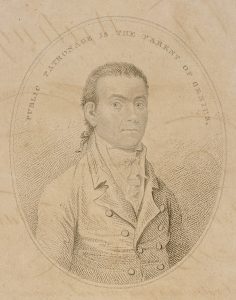
There are numerous styles of handwritten cursive that have been used during the last four centuries. Cursive handwriting can be defined as handwriting that connects the lowercase letters. Within this broad definition, there are both italic cursive types and looping cursive types.
A fine example of an italic cursive type is the Getty-Dubay Italic cursive method. Italic cursive is distinguished by the use of both a connected cursive letterform as well as an unconnected form. Also, the italic unconnected letterform is almost identical to the connected letterform.
In contrast, looping cursive methods primarily have only one letterform. A fine example of a looping cursive type is Spencerian . Although later methods of cursive did also teach a manuscript letterform, the manuscript letter form is entirely separate from the looping cursive form. An example of a handwriting method that taught both manuscript and looping cursive is D’Nealian .
In this article, I focus on the handwritten looping cursive types that have been used in the United States. Even within this area of focus, there is a wide range of handwritten cursive types and styles that have been used at different times.
Through each style, cursive evolved over time. Still, the beauty of the well-crafted and practiced handwriting remained, from the beautifully flowing flourishes of Spencerian to the tempered but mechanically fast Palmer Method. They are all beautiful, with their own strengths and qualities.
List of Cursive Types
English roundhand.
- John Jenkins’ method
- Spencerian Script
Palmer Method
Zaner-bloser.
- D’Nealian
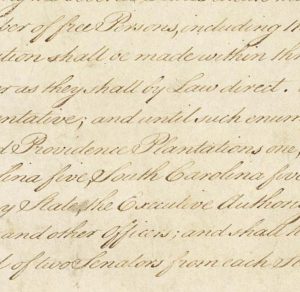
The earliest cursive type used in the United States was primarily imported from England and is found in the early documents that built America. This cursive style is generally called English Roundhand.
This cursive type was also used in printing, where it was engraved into copper plates. As the name suggests, English Roundhand is sometimes referred to as Copperplate because of its use in early printing. The classic instruction manual for this cursive style was “The Universal Penman,” initially published in London in 1733 by George Bickham.
English Roundhand can be seen on many of the oldest documents in US history. The Constitution and the Declaration of Independence were handwritten in English Roundhand cursive. Until the late 18th century, English Roundhand remained the primary style of cursive in the US.
John Jenkin’s Method
John Jenkins developed the first truly American style of cursive. In 1791, Jenkins published the first edition of “ The Art of Writing, Reduced to a Plain and Easy System .”
The Jenkins system of cursive handwriting began to take hold as it was increasingly taught in American schools. Being the first entirely American handwritten cursive type, it had solid support from elite writers such as John Adams, Benjamin Franklin, and John Hancock.
His second version, published in 1813, firmly replaced English Roundhand as the primary cursive style in America.
In the 1860s, a new cursive style emerged, known as Spencerian Script. Platt Rogers Spencer, whom this handwritten cursive type is named, developed a new method of cursive that was faster, more legible, and yet still elegant.
His children later published Spencerian Script in 1866 with the teaching manual, “ Spencerian Key to Practical Penmanship . ” Spencerian script remained the dominant cursive style taught and used up until the early 1900s.
Extended Cursive Letterforms
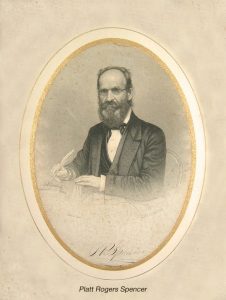
Spencerian script was the last cursive style that used the extended form with certain cursive letters. Within Spencerian lowercase letters, there were short letters like the cursive w, semi-extended letters like the cursive d, and extended letters like the cursive h.
Extended cursive letterforms were also applied to the downward looping letters that extend below the baseline, like the cursive p or cursive f. An example of a short-extended letter is the cursive p, which extends just past a third of a line below the baseline. An example of an extended downward looping letter is the cursive f. The cursive f extends two-thirds of a line below the baseline.
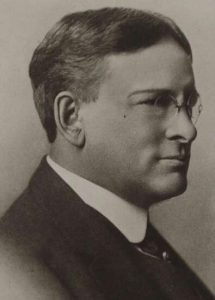
This extended cursive letterform is included in Spencerian script, John Jenkins method, and English Roundhand. After Spencerian Script, extended lowercase cursive letters were abandoned. Some writers have expressed issues with the extended lower looping letters because they interfere with the following line of writing.
Letters like the cursive f, which had previously extended farther below the baseline, had to be spatially avoided in the following line of writing to avoid overlapping letters. Cursive letters overlapping from two separate lines look disorganized and lacks aesthetics. This is a fair point considering that proper cursive uses consistent degrees in the slant angles, making overlapping cursive letters harder to distinguish.
Issues aside, I like the extended lowercase letters. I think they add flair to the handwritten cursive script by breaking up monotonous strings of letters at the same height. However, back then, since cursive writing was increasingly required in all levels of society and business, consistent letter height increased valuable qualities such as speed and legibility.
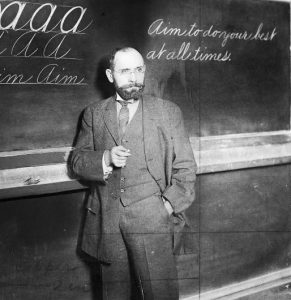
The next prominent cursive style to emerge in America was the Palmer Method. This handwritten cursive type was developed by Austin Palmer and published in 1894 as “ Palmer’s Guide to Business Writing .”
The Palmer Method brought several changes to cursive, with the whole arm muscle movement being the most significant. This method introduced the physical form of using only arm movements to write, expressly excluding finger movements. The rationale related to the arm having larger muscles than the hand, which reduced fatigue.
The Palmer Method of handwritten cursive was intended to be very quickly written, clearly legible, and still elegant enough for business correspondence. Part of the reason for the emphasis on speed was the competition with the increasingly used typewriters.
The introduction of the Palmer Method of cursive eventually led to substantial book sales and several awards. Part of the reason for this success was the emphasis on every student having a copy of the book. To this extent, Palmer emphasized the need to abandon copybooks of the past. He stressed the importance of learning the mechanics of cursive writing with the arm for speed and legibility, rather than merely copying examples repeatedly.
One of the hallmarks of the Palmer Method handwritten cursive type was rhythmic and timed exercises made up of simple shapes, created to train the arm muscles. Before the Palmer Method, students had extensively used copy books to trace over prewritten letters, which taught precision over speed. However, by the 1950s, the Palmer Method cursive style was phased out and replaced.
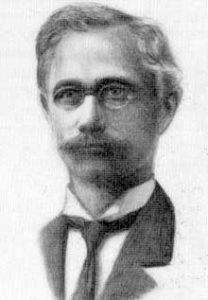
In the late 1940s, schools began teaching manuscript handwriting first, then cursive handwriting second. Manuscript is the method of handwriting that uses a separation between letters, commonly referred to as printing.
In 1948, Charles Zaner and Elmer Bloser published their cursive method, the Zaner-Blosser method. By the 1950s, the Zaner-Bloser method had become the dominant teaching method for handwriting in America.
The Zaner-Bloser method was the first major published method to teach manuscript letterforms first. After the students had sufficiently learned manuscript letterforms, then cursive was introduced to the students. The rationale behind teaching manuscript letterforms first was to allow students to begin handwriting at an earlier age.
The more simple manuscript letterforms were easier to teach to younger students, which allowed the students to begin written expression at an earlier age. The Zaner-Bloser method begins with teaching very simple letterforms without any slant or letter connection.
Though the Zaner-Bloser Company is better known for their manuscript first then cursive method, they did publish their first method in 1904. “ The Zaner Method of Arm Movement Writing ” was published by the Zaner-Bloser Company in 1904, and was generally considered a simplified Spencerian method. It also incorporated some of the Palmer Method arm movement practice techniques.
D’Nealian Method
The D’Nealian method was published in 1978 and became the primary competitor to the Zaner-Bloser Company. The D’Nealian method was based on the same principle of teaching children manuscript handwriting first. Then, later, cursive would be introduced to the students in a later grade.
However, the D’Nealian method taught manuscript handwriting with a slant. The founder of D’Nealian, Donald Thurber, thought that learning manuscript letterforms with a slant would create an easier transition to cursive for students.
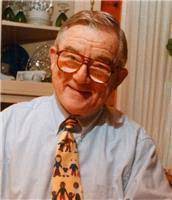
From here, it’s been a slow decline for cursive handwriting in America. The Common Core State Standards Initiative, supported by the National Governors Association and the Council of Chief State School Officers, has introduced education standards for schools. The Common Core Standards, which do not require the teaching of cursive, have been adopted by a majority of the states. Some states are still teaching cursive, but it’s no longer an educational standard.
However, cursive is currently experiencing a period of rediscovery. There is an emerging trend that is seeking to bring back the personalization that cursive handwriting possessed.
Today, the remaining school programs that still teach cursive primarily use either the D’Nealian or Zaner-Bloser method. Both the Zaner-Bloser and D’Nealian handwriting methods are still in print.
I enjoy writing in cursive and practicing cursive. I particularly enjoy many of the exercises used in the Palmer Method, such as the rhythmic repetitions of circles using only arm movement. The Palmer Method exercises have an almost meditative quality that I find relaxing. In terms of pure aesthetics, I tend to favor English Roundhand because of its flourished and extended cursive letterforms.
Additional Images and Examples
There are some additional images below with descriptions from the original publications of the writers in this article. I also gave a few image examples of the cursive extended letterform. If you enjoyed this article, I also wrote an article about the potential benefits of cursive used with current technology, linked here .
This is a page from “The Art of Writing, Reduced to a Plain and Easy System”, by John Jenkins, first published in 1791. Note the reference to the slope angle. A consistent angle is an important element of cursive.
This is another page from “The Art of Writing, Reduced to a Plain and Easy System”, by John Jenkins. Notice the fully extended cursive h on the right page.
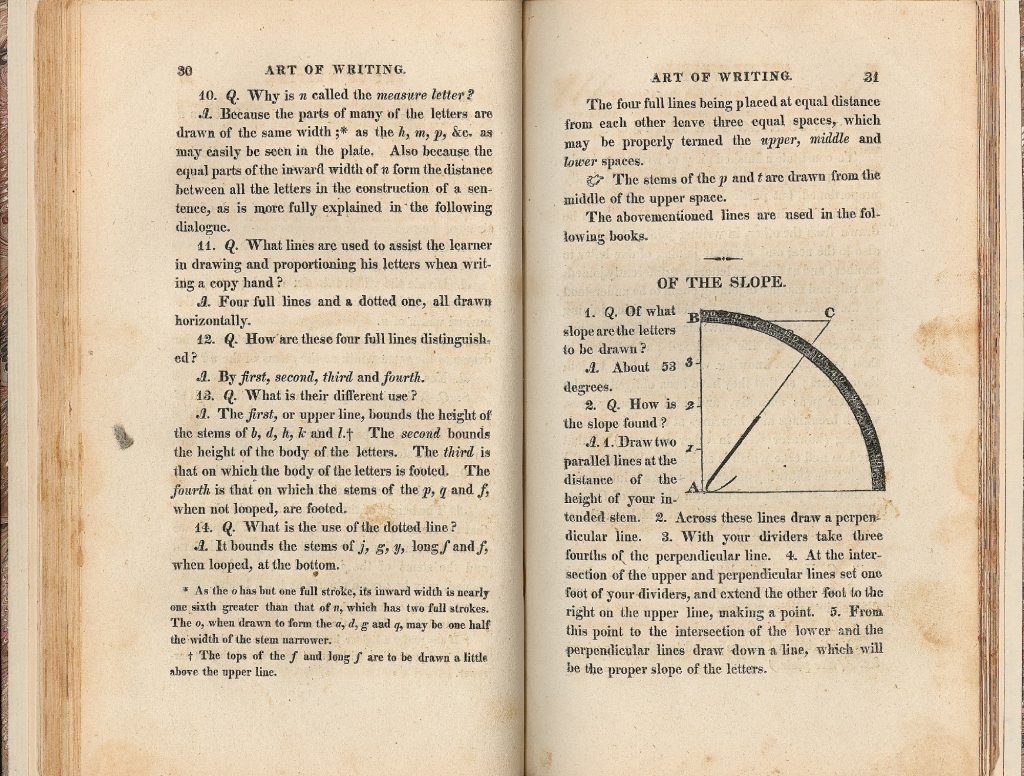
This is a page from Platt Rogers Spencer’s “Spencerian Key to Practical Penmanship”, published 1866. Notice the reference to the Extended Letters. Spencerian Script was one of the last cursive types to use the extended letterforms.
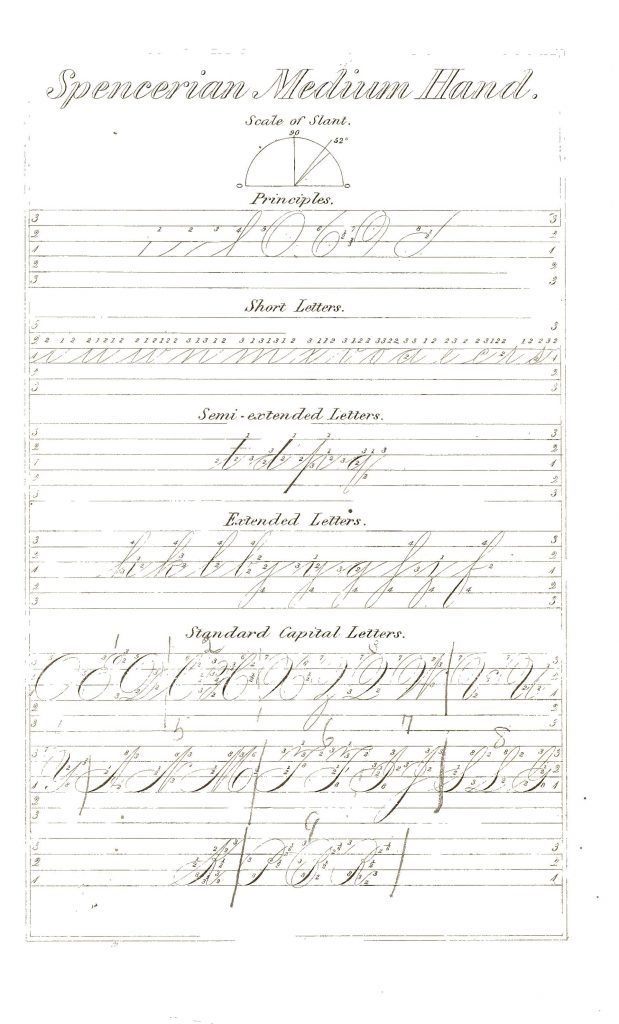
This is a page taken from Austin Palmer’s “Palmer’s Guide to Business Writing”, published in 1894. This type of cursive was designed to be written rapidly. Notice the larger separation between the letters, and the shorter cursive h.
This is the cover of Austin Palmer’s “The Palmer Method of Business Writing.”
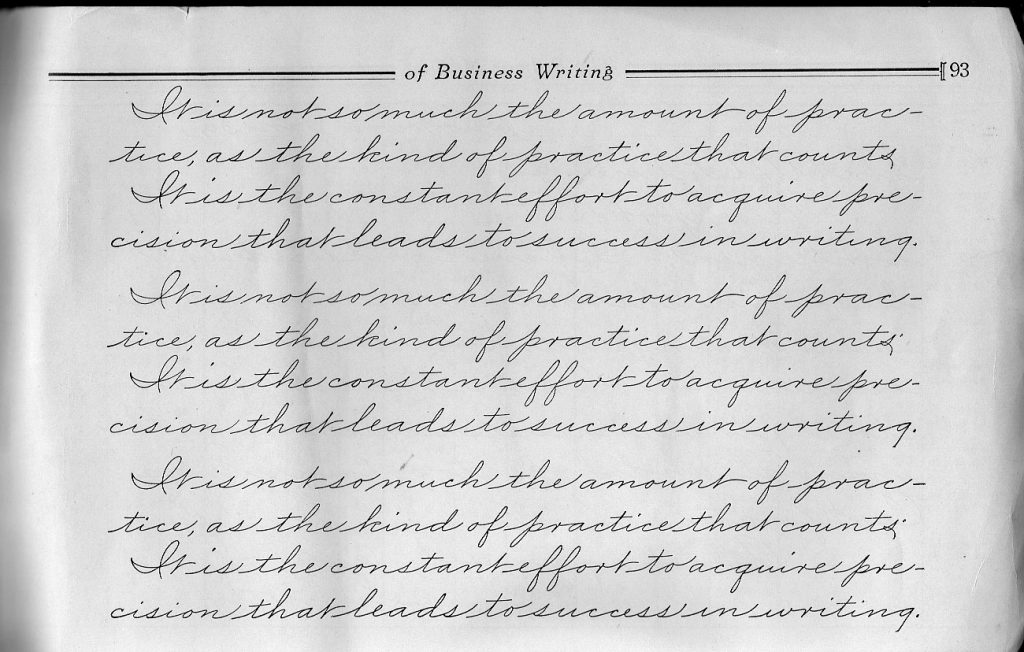
This is the introduction page from Platt Rogers Spencer’s “Spencerian Key to Practical Penmanship.”
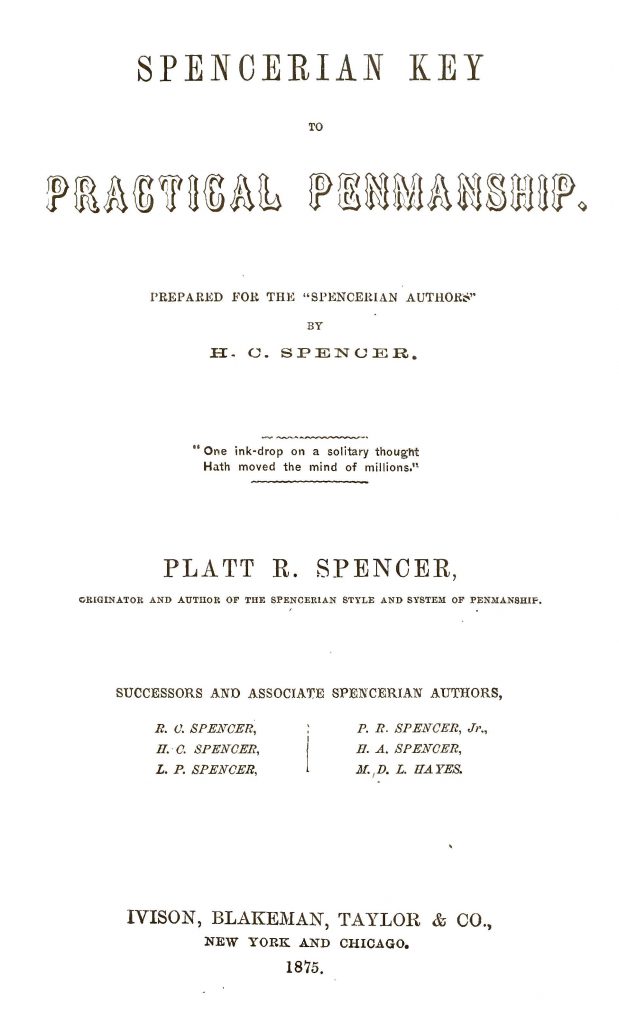
The Joy of Teaching
Sharing creative ideas and lessons to help children learn.

How to Teach My Child Cursive: Complete Instructions
May 1, 2018 by Evan-Moor | 4 Comments

Do you believe in the importance of teaching cursive handwriting?
If your school isn’t teaching your child contemporary or traditional cursive handwriting, you can teach him or her at home with just a little practice a day. Activities involving writing in cursive for kids are still seen as worthwhile endeavors. Many studies have demonstrated the importance of handwriting within children’s brain functions when learning. Often, children recall and retain more information when they write verses listening or typing.
Is there a specific method for learning how to teach cursive writing?
Cursive instruction is usually taught in the 3rd and 4th grades. At these grade levels, children are gaining solid skills in reading and writing comprehension. Before beginning lessons, observe your child’s fine motor skills. Make sure your child has mastered print handwriting and can identify each letter easily before introducing cursive letters.
Steps to Teaching Your Child Cursive Handwriting
Step 1: Introduce one cursive letter at a time
Think of your child as re-learning to write the alphabet one letter at a time. Each letter should be introduced slowly and practiced consistently before moving on to the next step.
Step 2: Begin with teaching lowercase cursive letters
Begin by teaching only the lowercase letters of the alphabet. Start with letters that are similar in form to print letters such as c, a, d, and g. You may also group letters together by formation patterns and difficulty. Begin with the simplest letters and end with the most difficult and infrequently used ones. 1. c, a, d, g 2. h, t, p, e, l, f, q 3. u, i, j, k, r, s 4. o, b, v, w 5. m, n, y, x, z
Step 3: Then teach uppercase cursive letters
Once the lowercase letters are mastered, begin pairing them with the uppercase version in this order. 1. A, C, O, U 2. V, W, X, Y, Z 3. P, R, B, H, K 4. N, M, J, F, T 5. I, D, L, G, S 6. E, Q
Step 4: Have your child copy simple sentences
After introducing and practicing upper- and lowercase letters, have your child start copying simple sentences. Be sure to observe and demonstrate how to connect letters together.
Here are a few examples from Daily Handwriting Practice: Contemporary Cursive:
A continent is a large landmass. North America is north of the equator. South America is south of the equator.
Download this free sample page from Daily Handwriting Practice: Contemporary Cursive .
Step 5: Progress to copying simple paragraphs
Copying simple and short paragraphs is the last step in learning how to write in cursive. Continual practice using many different letters is the key to mastering cursive handwriting.
Hints for Teaching Cursive:
Teaching cursive writing to kids requires constant engagement. To ensure letters are being handwritten in cursive correctly, handwriting must be demonstrated and monitored. Don’t leave children to figure out how to connect the letters. Be sure to demonstrate and monitor letter formation and practice.
Use the correct paper. Cursive is difficult to learn on regular lined student paper. Invest in dotted lined paper (the type used in kindergarten and first grade) so children have a reference when writing lower- and uppercase letters.
Allow children to move their paper diagonally so they can create the correct slant of letters.
Some children love writing and learning cursive, while others prefer to print. It is important to let your child choose the method he or she prefers. Handwriting (whether print or cursive) aids in learning and allows students to make discoveries about themselves and how they learn best.
Hidden handwriting benefits Both manuscript and cursive handwriting are important foundations in children’s development of thinking, language, and memory. Studies have repeatedly proven that writing verses typing stimulates the connections between the right and left hemispheres of the brain in areas of memory and language. In a 2014 study from The Pen Is Mightier Than the Keyboard: Advantages of Longhand Over Laptop Note Taking, students who hand wrote their notes outperformed their typing peers on conceptual questions in three separate studies.
Here’s additional research on the benefits of teaching children cursive writing: Campaign for Cursive Research What’s Lost as Handwriting Fades The Pen Is Mightier Than the Keyboard: Advantages of Longhand Over Laptop Note Taking
Make It Fun!
- Practice letter formation on a chalkboard with a wet paintbrush.
- Write with white crayons on black construction paper.
- Create textured cursive letters: write words in glue and cover them with glitter.
Easy Methods for Teaching Handwriting If you are looking for a simple resource to teach your child cursive, check out Evan-Moor’s Daily Handwriting Practice Contemporary Cursive (available for grades K–6). Daily Handwriting Practice is available in four titles: modern manuscript, traditional manuscript, traditional cursive, and contemporary cursive. You will have ready-to-go handwriting exercises to help your child master handwriting skills in 15 minutes a day or less.

Leave a reply →
Leave a Reply Cancel reply
Subscribe Today!
Sign-up for education inspiration for PreK–8 teachers and parents.
Email address:
Grade Level Pre-K Kindergarten 1st Grade 2nd Grade 3rd Grade 4th Grade 5th Grade 6th Grade 7th Grade +
I am a ... Teacher Homeschooler Parent School Admin Other
By submitting this form, you are consenting to receive emails from Evan-Moor. You can unsubscribe at any time by using the Unsubscribe link found at the bottom of every email.
- Skip to main content
- Keyboard shortcuts for audio player
Your Health
- Treatments & Tests
- Health Inc.
- Public Health
Why writing by hand beats typing for thinking and learning
Jonathan Lambert

If you're like many digitally savvy Americans, it has likely been a while since you've spent much time writing by hand.
The laborious process of tracing out our thoughts, letter by letter, on the page is becoming a relic of the past in our screen-dominated world, where text messages and thumb-typed grocery lists have replaced handwritten letters and sticky notes. Electronic keyboards offer obvious efficiency benefits that have undoubtedly boosted our productivity — imagine having to write all your emails longhand.
To keep up, many schools are introducing computers as early as preschool, meaning some kids may learn the basics of typing before writing by hand.
But giving up this slower, more tactile way of expressing ourselves may come at a significant cost, according to a growing body of research that's uncovering the surprising cognitive benefits of taking pen to paper, or even stylus to iPad — for both children and adults.
Is this some kind of joke? A school facing shortages starts teaching standup comedy
In kids, studies show that tracing out ABCs, as opposed to typing them, leads to better and longer-lasting recognition and understanding of letters. Writing by hand also improves memory and recall of words, laying down the foundations of literacy and learning. In adults, taking notes by hand during a lecture, instead of typing, can lead to better conceptual understanding of material.
"There's actually some very important things going on during the embodied experience of writing by hand," says Ramesh Balasubramaniam , a neuroscientist at the University of California, Merced. "It has important cognitive benefits."
While those benefits have long been recognized by some (for instance, many authors, including Jennifer Egan and Neil Gaiman , draft their stories by hand to stoke creativity), scientists have only recently started investigating why writing by hand has these effects.
A slew of recent brain imaging research suggests handwriting's power stems from the relative complexity of the process and how it forces different brain systems to work together to reproduce the shapes of letters in our heads onto the page.
Your brain on handwriting
Both handwriting and typing involve moving our hands and fingers to create words on a page. But handwriting, it turns out, requires a lot more fine-tuned coordination between the motor and visual systems. This seems to more deeply engage the brain in ways that support learning.

Shots - Health News
Feeling artsy here's how making art helps your brain.
"Handwriting is probably among the most complex motor skills that the brain is capable of," says Marieke Longcamp , a cognitive neuroscientist at Aix-Marseille Université.
Gripping a pen nimbly enough to write is a complicated task, as it requires your brain to continuously monitor the pressure that each finger exerts on the pen. Then, your motor system has to delicately modify that pressure to re-create each letter of the words in your head on the page.
"Your fingers have to each do something different to produce a recognizable letter," says Sophia Vinci-Booher , an educational neuroscientist at Vanderbilt University. Adding to the complexity, your visual system must continuously process that letter as it's formed. With each stroke, your brain compares the unfolding script with mental models of the letters and words, making adjustments to fingers in real time to create the letters' shapes, says Vinci-Booher.
That's not true for typing.
To type "tap" your fingers don't have to trace out the form of the letters — they just make three relatively simple and uniform movements. In comparison, it takes a lot more brainpower, as well as cross-talk between brain areas, to write than type.
Recent brain imaging studies bolster this idea. A study published in January found that when students write by hand, brain areas involved in motor and visual information processing " sync up " with areas crucial to memory formation, firing at frequencies associated with learning.
"We don't see that [synchronized activity] in typewriting at all," says Audrey van der Meer , a psychologist and study co-author at the Norwegian University of Science and Technology. She suggests that writing by hand is a neurobiologically richer process and that this richness may confer some cognitive benefits.
Other experts agree. "There seems to be something fundamental about engaging your body to produce these shapes," says Robert Wiley , a cognitive psychologist at the University of North Carolina, Greensboro. "It lets you make associations between your body and what you're seeing and hearing," he says, which might give the mind more footholds for accessing a given concept or idea.
Those extra footholds are especially important for learning in kids, but they may give adults a leg up too. Wiley and others worry that ditching handwriting for typing could have serious consequences for how we all learn and think.
What might be lost as handwriting wanes
The clearest consequence of screens and keyboards replacing pen and paper might be on kids' ability to learn the building blocks of literacy — letters.
"Letter recognition in early childhood is actually one of the best predictors of later reading and math attainment," says Vinci-Booher. Her work suggests the process of learning to write letters by hand is crucial for learning to read them.
"When kids write letters, they're just messy," she says. As kids practice writing "A," each iteration is different, and that variability helps solidify their conceptual understanding of the letter.
Research suggests kids learn to recognize letters better when seeing variable handwritten examples, compared with uniform typed examples.
This helps develop areas of the brain used during reading in older children and adults, Vinci-Booher found.
"This could be one of the ways that early experiences actually translate to long-term life outcomes," she says. "These visually demanding, fine motor actions bake in neural communication patterns that are really important for learning later on."
Ditching handwriting instruction could mean that those skills don't get developed as well, which could impair kids' ability to learn down the road.
"If young children are not receiving any handwriting training, which is very good brain stimulation, then their brains simply won't reach their full potential," says van der Meer. "It's scary to think of the potential consequences."
Many states are trying to avoid these risks by mandating cursive instruction. This year, California started requiring elementary school students to learn cursive , and similar bills are moving through state legislatures in several states, including Indiana, Kentucky, South Carolina and Wisconsin. (So far, evidence suggests that it's the writing by hand that matters, not whether it's print or cursive.)
Slowing down and processing information
For adults, one of the main benefits of writing by hand is that it simply forces us to slow down.
During a meeting or lecture, it's possible to type what you're hearing verbatim. But often, "you're not actually processing that information — you're just typing in the blind," says van der Meer. "If you take notes by hand, you can't write everything down," she says.
The relative slowness of the medium forces you to process the information, writing key words or phrases and using drawing or arrows to work through ideas, she says. "You make the information your own," she says, which helps it stick in the brain.
Such connections and integration are still possible when typing, but they need to be made more intentionally. And sometimes, efficiency wins out. "When you're writing a long essay, it's obviously much more practical to use a keyboard," says van der Meer.
Still, given our long history of using our hands to mark meaning in the world, some scientists worry about the more diffuse consequences of offloading our thinking to computers.
"We're foisting a lot of our knowledge, extending our cognition, to other devices, so it's only natural that we've started using these other agents to do our writing for us," says Balasubramaniam.
It's possible that this might free up our minds to do other kinds of hard thinking, he says. Or we might be sacrificing a fundamental process that's crucial for the kinds of immersive cognitive experiences that enable us to learn and think at our full potential.
Balasubramaniam stresses, however, that we don't have to ditch digital tools to harness the power of handwriting. So far, research suggests that scribbling with a stylus on a screen activates the same brain pathways as etching ink on paper. It's the movement that counts, he says, not its final form.
Jonathan Lambert is a Washington, D.C.-based freelance journalist who covers science, health and policy.
- handwriting

Project PHaEDRA - Muriel & Sylvia Mussells - Positions of nebulae, 14. #G46
About the project.
At Harvard College Observatory (now the Center for Astrophysics | Harvard & Smithsonian), Women Astronomical Computers studied glass plate photographs of the night sky. Here they cataloged stars, identified variables, interpreted stellar spectra, counted galaxies, and measured the vast distances in space. Several of them made game-changing discoveries in astronomy and astrophysics. In these books, you can follow the work of Sylvia and Muriel Mussells, two sisters who worked at the Harvard College Observatory in the 1920s and 1930s. Muriel Mussells discovered three new ring nebulae in the Milky Way and Sylvia Mussells discovered the first dwarf galaxy. You can help us find out what else we can learn about them and their work! PLEASE NOTE: The Project PHaEDRA Instructions for Women Computers Notebooks were heavily revised and republished on August 18, 2023. Please take a moment to familiarize yourself with these instructions.
At Harvard College Observatory (now the Center for Astrophysics | Harvard & Smithsonian), Women Astronomical Computers studied glass plate photographs of the night sky. Here they cataloged stars, identified variables, interpreted stellar spectra, counted galaxies, and measured the vast distances in space. Several of them made game-changing discoveries in astronomy and astrophysics. In these books, you can follow the work of Sylvia and Muriel Mussells, two sisters who worked at the Harvard College Observatory in the 1920s and 1930s. Muriel Mussells discovered three new ring nebulae in the Milky Way and Sylvia Mussells discovered the first dwarf galaxy. You can help us find out what else we can learn about them and their work! Interested in historical women? Love astronomy? Help us transcribe the work of the Harvard College Observatory's women computers and see which stars shine the brightest. You can sign up for our Project PHaEDRA newsletter here . Have questions? Want to start a discussion? Head over to our blog posts to make comments about notebooks and ask questions. Recently, research material originally produced during the mid-to-late 19th and early 20th centuries by researchers at the Harvard College Observatory was re-discovered in the HCO Plate Stacks holdings. These early notebooks and other materials are absolutely irreplaceable. The material represents the history of the Harvard College Observatory and comprises remarkable examples of primary source material showing the evolution of observation methods, along with early astronomy as a whole. The documents are also relevant to the history of women in science as the collection contains material produced by the Women Astronomical Computers. Women like Williamina Fleming, Annie Jump Cannon, Henrietta Swan Leavitt, Cecilia Payne-Gaposchkin and Antonia Maury made their mark in astronomy (and history!) here by studying these glass plates and publishing their findings in their own name. See an interesting bit, note, or image in the margins? Tell us about it on Twitter or Instagram @ProjectPHaEDRA ! For more information about this collection, check out the Plate Stacks website or contact the John G. Wolbach Library and ask about Project PHaEDRA . If you're a teacher or student, check out our resources about the Harvard Computers and other female astronomers on the Smithsonian Learning Lab .
About Project Difficulty
Level 1 - beginner.
Content: all typed Language: English Format: letters, diaries, flyers, pamphlets, and one-page documents Subject Area Expertise/Special Skills: none required
Content: mostly typed, handwritten in print, or otherwise very clearly written/readable Language: English Format: memorabilia, advertisements, image captions, telegrams, diaries, letters, notes Subject Area Expertise/Special Skills: none required
Level 3 - INTERMEDIATE
Content: typed and handwritten materials in cursive or print Language: English Format: newspaper clippings, scrapbooks, letters/diaries/notes that may include annotations or margin notes Subject Area Expertise/Special Skills: experience reading cursive writing may be useful
Content: handwritten materials, primarily in cursive or somewhat difficult to read (predominantly from the 19th and 20th centuries) , audio recordings that are relatively easy to hear/decipher, and scientific materials Language: English and/or other languages that use Roman script but may require the use of diacritics (French, Spanish, German, Italian, etc.) Format: audio recordings, letters, diaries, notes and other written materials, projects with templated fields and special instructions Subject Area Expertise/Special Skills: some knowledge of non-English Roman-character/script languages and diacritics may be useful, as well as experience reading cursive handwriting. A general knowledge or familiarity with scientific terminology.
Level 5 - ADVANCED
Content: handwritten materials in cursive (from the 19th century or earlier) or in a non-Roman script language, audio recordings that are difficult to hear or are not in English, specialty materials/projects such as numismatics projects and the Project Phaedra notebooks Language: foreign languages that use non-Roman characters (Chinese, Japanese, Arabic, Greek/Cyrillic, Native American and Indigenous languages, etc.) and English Format: audio recordings, columned data/tables, manuscripts, letters, diaries, notes, currency sheets, coins Subject Area Expertise/Special Skills: knowledge of a specific language and access to a keyboard with the characters in that language may be required for certain projects. Experience reading cursive handwriting and familiarity with 19th century (or prior) handwriting and conventions/abbreviations may be useful, as well as knowledge of scientific terminology, astrophysics data, or linguistics.
Contributing members
Total pages

IMAGES
VIDEO
COMMENTS
Sample writing from The Palmer Method of Business Writing. The Palmer Method of penmanship instruction was developed and promoted by Austin Palmer in the late 19th and early 20th centuries. It was intended to simplify the earlier "Spencerian method", which had been the main handwriting learning method since the 1840s.The Palmer Method soon became the most popular handwriting system in the ...
6. Spencerian Cursive (or Spencerian Script) This is one of the oldest, and arguably most beautiful forms of writing. It's also a difficult place to start when beginning your cursive journey. That said, it's really fun to look at and the ability to write in this gorgeous style is something worth striving to achieve.
Descriptions. Cursive is a style of penmanship in which the symbols of the language are written in a conjoined and/or flowing manner, generally for the purpose of making writing faster. This writing style is distinct from "print-script" using block letters, in which the letters of a word are unconnected and in Roman/Gothic letterform rather than joined-up script.
The Palmer method intended to teach businessmen to write clearly and efficiently, without the ornamentation common in cursive writing. Though originally intended for business use, the Palmer method also gained popularity in schools. These methods of cursive writing were entwined with the technology available at the moment of their development.
Two young girls practice their cursive handwriting on a small blackboard, circa 1935. With the help of drills, examinations, and even penmanship competitions, the Palmer Method became the dominant ...
The Palmer Method of Writing Efforts to improve cursive script continued throughout the 1800s, and by the 1880s and 90s, a new script had emerged: The Palmer Script. Like Roundhand and Spencerian which preceded it, Palmer was an attempt to cut down on needless frivolity and improve legibility. Lowercase letters such as 's' and 'r' were ...
In this first video, I discuss what The Palmer Method is and who Palmer was. The Palmer Method is a system of handwriting developed by Austin Norman Palmer in the late 19th-century. Palmer was a penmanship instructor that eventually landed a job at Cedar Rapids Business College in Iowa around 1880. It was here that he began developing The ...
He has posted over 100 videos on YouTube teaching cursive. David also studies and teaches the traditional method of writing called, "muscular movement" (aka Palmer Method), where the arm is used to write cursive script. Consistent Cursive does not teach muscular movement, but is a great first step towards learning it.
In the 1800s, an American bookkeeper by the name of Platt Rogers Spencer regularized a method of cursive writing, a script known as the Spencerian Method. This style of writing was taught in ...
From the 1850s into the 1920s, Spencerian script was the primary cursive handwriting taught in many schools in the United States. In the late 1880s, Austin Palmer introduced the Palmer Method of cursive writing which emphasized arm movements over finger movements and used plainer, less elaborate letter shapes than the popular Spencerian script.
Types of Cursive Writing. Most adults develop their own unique way of writing, usually cobbled together from printing and cursive techniques. In schools, one form of cursive is usually chosen and taught, and most often it's one of four common cursive handwriting types: New American Cursive, Handwriting Without Tears, D'Nealian and Zaner-Bloser ...
The Palmer Method streamlined the flourishes of the Spencerian Method, creating a simpler and faster system of writing. First introduced through his 1894 book Palmer's Guide to Business Writing, the Palmer Method was originally designed for use in business colleges. As it gained popularity, it was widely adopted by public school systems.
An example of D'Nealian print writing Using The School Oblique Typeface. The D'Nealian Method (sometimes misspelled Denealian) is a style of writing and teaching handwriting based on Latin script which was developed between 1965 and 1978 by Donald N. Thurber (1927-2020) in Michigan, United States.Building on his experience as a primary school teacher, Thurber aimed to make the transition ...
Zaner-Bloser Method. The Zaner-Bloser method is the most widely recognized way that students have learned cursive writing. With Zaner-Bloser, students learn to write a block-style form of the ...
The Palmer Method is a system of writing that gained prominence in the United States in the early 20 th century. It involves emphasizing arm movements when writing rather than finger movements. Writing speed and efficiency thus supposedly increase. During its prime, it became one of the most widely used methods of cursive writing.
American Cursive is a practical system of handwriting based on the Palmer Method and is great for everyday use like writing in your journal, writing a letter, or even writing law school exam answers. What's great about American Cursive is you don't need a fancy calligraphy pen, fountain pen, or quill.
Hybrid writing. "By 1946, 66 percent of schools were instructing manuscript as an introductory method of handwriting before switching to cursive in Grade 3 or later," says Donica. This method ...
The Study Plan Gives You…. 35 videos covering 80+ lessons and 100+ drills from The Palmer Method of Business Writing. Watch and learn from an accomplished practitioner! A schedule to guide your practice. The schedule outlines over 100 sessions for you to practice between videos. Know the time you spend practicing will lead to results!
The next prominent cursive style to emerge in America was the Palmer Method. This handwritten cursive type was developed by Austin Palmer and published in 1894 as " Palmer's Guide to Business Writing .". The Palmer Method brought several changes to cursive, with the whole arm muscle movement being the most significant.
Step 1: Introduce one cursive letter at a time. Think of your child as re-learning to write the alphabet one letter at a time. Each letter should be introduced slowly and practiced consistently before moving on to the next step. Step 2: Begin with teaching lowercase cursive letters.
The Palmer Method, created by Austin Norman Palmer in the late 19th-century, started a new trend in American penmanship and went on to become the most popular handwriting system of the 20th-century. Start learning the Palmer Method by reading the FAQs and watching the Intro Series. The Palmer Method of Business Writing - Free PDF […]
These worksheets showcase the Palmer Method of Penmanship, a simple approach to writing. Unlike Spencerian script, the Palmer method has few flourishes, making it a good choice for students and daily handwriting. Trace each letter pair, paying special attention to the height and shape of each letter. The last page is a blank practice sheet.
Spencerian script is a script style based on Copperplate script that was used in the United States from approximately 1850 to 1925, [1] [2] and was considered the American de facto standard writing style for business correspondence prior to the widespread adoption of the typewriter. Spencerian script, an American form of cursive handwriting ...
A slew of recent brain imaging research suggests handwriting's power stems from the relative complexity of the process and how it forces different brain systems to work together to reproduce the ...
These early notebooks and other materials are absolutely irreplaceable. The material represents the history of the Harvard College Observatory and comprises remarkable examples of primary source material showing the evolution of observation methods, along with early astronomy as a whole.